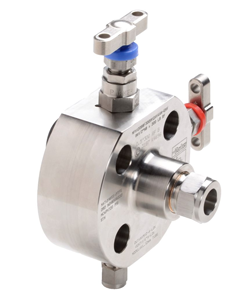Parker Monoflange Process to Instrument Valve

The monoflange allows the mounting options to suit whether the pipeline is vertical or horizontal, the gauge or pressure transmitter can be fitted on either the front face or on the outer diameter of the body to allow good orientation and ease of reading.
Parker’s monoflange is available in a wide range of single-, two- and three-valve configurations, including block, double-block, block-and-bleed, double-block-and-bleed and block-bleed-block. Standard flange sizes include 1/2", 3/4", 1”, 1-1/2” and 2”, together with API and DIN standard versions, and there is a extensive choice of flange classes, from ANSI 150 to 2500. Standard outlet vents are 1/2" female NPT. Depending on monoflange size and configuration, other options include 1/4", 3/8”, 6 mm, 10 mm and 12 mm sizes, and male NPT or Parker inverted A-LOK™ double ferrule compression fittings.
Monoflange Process to Instrument Valve Markets:
- Oil and Gas Offshore
- Oil and Gas Onshore
- Petrochemical
- Chemical
Monoflange Process to Instrument Valve Features/Benefits:
- Close coupled
- One piece forged construction
- Shell TAT approval and meets MESC SPE 77/300
- Heat code traceable and NACE compliant materials
- ISO 15848 Class A (HS) and B standards
- Integral two and single ferrule connections, which reduces potential leak paths
- Reduced weight
- Reduced installation costs - can be fitted faster than traditional valves
- Fewer components
- Fire-safe versions that extend this to 538˚C (1000˚F)
- Corrosion resistant alloys
Monoflange Process to Instrument Valve Applications:
- Chemical injection
- Process to instrument interface
- Gas or light liquid service
Monoflange Process to Instrument Valve Tech Specifications:
PRIMARY ISOLATE - OS & Y, Needle ValveCONFIGURATION - Block-Block-Bleed, Block-Bleed
MATERIAL - 316 Stainless Steel, Carbon Steel, Duplex
FLANGE SIZE (INCH) - 1/2", 3/4", 1", 1 1/2", 2"
FLANGE FACE - Raised Face Spiral, Ring Type Joint
ANSI FLANGE CLASS - 150, 300, 600, 900, 1500, 2500
CONNECTION SIZE (INCH) - 1/2" NPT F
PLUGGED VENT (INCH) - 1/4" NPT F
SEAL MATERIAL - PTFE, Graphoil
HANDLE - Stainless Steel Lever
CERTIFICATES - N/A, NACE, Fire Safe
MAXIMUM WORKING PRESSURE (PSI): 275, 720, 1440, 2160, 3600, 6000, 285, 740, 1480, 2220, 3705, 6170, 290, 750, 1500, 2250, 3750, 6250
MAXIMUM WORKING PRESSURE (BAR): 19, 50, 99, 149, 248, 414, 20, 51, 102, 153, 256, 426, 52, 103, 155, 259, 431
MAXIMUM WORKING TEMPERATURE (C): 204, 538
MAXIMUM WORKING TEMPERATURE (F): 400, 1000
MINIMUM WORKING TEMPERATURE (C): -29, -54
MINIMUM WORKING TEMPERATURE (F): -20, -65
INDUSTRY APPLICATIONS: Instrument Isolation, In Situ Calibration, Inline Process Isolation, Chemical Injection, Process Sampling
INDUSTRY STANDARDS: API 6A, API 607, PRL 2, PSL 2, PSL 3, PSL 4, TAMAP, MESC SPE 77/312
Contact us at (855) 737-4714 to learn more, or fill out our online form.
A lesson for me is that I need to involve you earlier in the program.
You were tireless in your support and it will not be forgotten!
